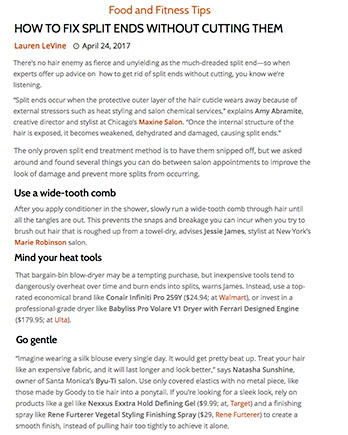Natura-Fitness.website
 Natura-Fitness
Natura-Fitness
How to Fix Split Ends Without cutting Them
There’s no hair enemy as fierce and unyielding as the much-dreaded split end—so when experts offer up advice on how to get rid of split ends without cutting, you know we’re listening.
“Split ends occur when the protective outer layer of the hair cuticle wears away because of external stressors such as heat styling and salon chemical services,” explains Amy Abramite, creative director and stylist at Chicago’s Maxine Salon. “Once the internal structure of the hair is exposed, it becomes weakened, dehydrated and damaged, causing split ends.”
The only proven split end treatment method is to have them snipped off, but we asked around and found several things you can do between salon appointments to improve the look of damage and prevent more splits from occurring.
Use a wide-tooth comb
After you apply conditioner in the shower, slowly run a wide-tooth comb through hair until all the tangles are out. This prevents the snaps and breakage you can incur when you try to brush out hair that is roughed up from a towel-dry, advises Jessie James, stylist at New York’s Marie Robinson salon.
Mind your heat tools
That bargain-bin blow-dryer may be a tempting purchase, but inexpensive tools tend to dangerously overheat over time and burn ends into splits, warns James. Instead, use a top-rated economical brand like Conair Infiniti Pro 259Y ($24.94; at Walmart), or invest in a professional-grade dryer like Babyliss Pro Volare V1 Dryer with Ferrari Designed Engine ($179.95; at Ulta).
Go gentle
“Imagine wearing a silk blouse every single day. It would get pretty beat up. Treat your hair like an expensive fabric, and it will last longer and look better,” says Natasha Sunshine, owner of Santa Monica’s Byu-Ti salon. Use only covered elastics with no metal piece, like those made by Goody to tie hair into a ponytail. If you’re looking for a sleek look, rely on products like a gel like Nexxus Exxtra Hold Defining Gel ($9.99; at, Target) and a finishing spray like Rene Furterer Vegetal Styling Finishing Spray ($29, Rene Furterer) to create a smooth finish, instead of pulling hair too tightly to achieve it alone.
Take folic acid and biotin
There’s a reason they say you are what you eat: Nutrients literally build the proteins that make up your hair strands. Two B vitamins in particular—folic acid and biotin—have been shown to supplement hair health, length, and thickness, says Sunshine.
Folic acid helps the production of red blood cells, which powers the growth of hair. Foods rich in folic acid include green leafy veggies, oranges, soybeans, and wheat. Biotin strengthens both hair and nails through its metabolism of fats, carbs, and proteins. Brown rice, lentils, peas, sunflower seeds, walnuts, and soybeans are all rich in biotin.
Use leave-in conditioner
Conditioners that you rinse out in the shower will do little to nothing for split ends, but a leave-in conditioner will add extra protection that stays on strands as you heat-style and go about your day. Try Living Proof Perfect Hair Day Fresh Cut Split End Mender ($24; at Sephora), which can be applied to wet or dry hair for anytime use.
Blow-dry the right way
Always use a nozzle on your dryer to control and direct the flow of air, and dry hair in a downward direction before sectioning off and drying completely with a round brush. This way, you spend far less time with intense heat straight on the hair. “If possible, air drying 90 percent before picking up the blow-dryer is even better,” says Sunshine. And of course, if you can naturally dry all the way, that’s always your best option.
Limit damaging services
There’s unfortunately no way around it—treatments like hair color, highlights, straightening, and perms all cause trauma that can result in a bevy of split ends, says Abramite. Try to limit service to just one major hair concern and refrain from washing strands for at least 48 hours afterward, when they’re most porous and likely to break and split. Not only will hair health improve after you go on a chemical-service diet, but your wallet will thank you.
Get regular cuts
Although a haircut is the only way to get rid of split ends, regular trims are your best protection against them. The longer you wait to trim, the greater the chance you have of split ends worsening and traveling up the shaft. It may sound counter-intuitive, but this is why it’s actually best to get frequent trims if you’re trying to grow longer, healthier hair. Whatever your hair type or style, our experts recommend you get a cut or trim at least every six to eight weeks.
